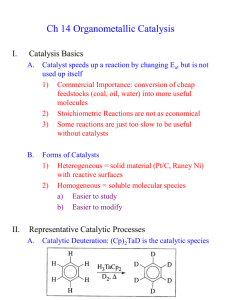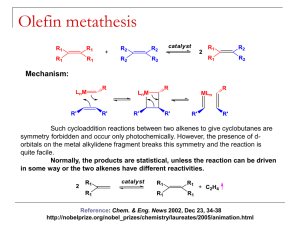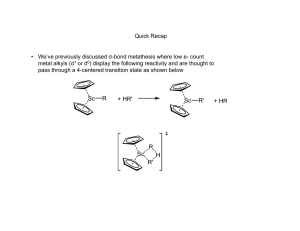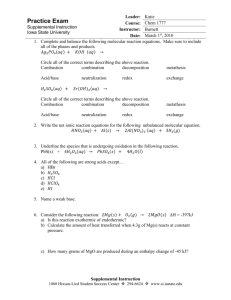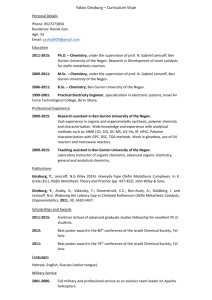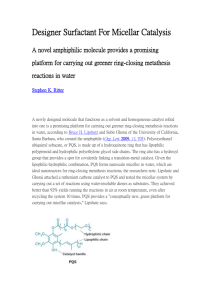Olefin Metathesis: Catalysts and Catalysis Matthew Cohan
advertisement
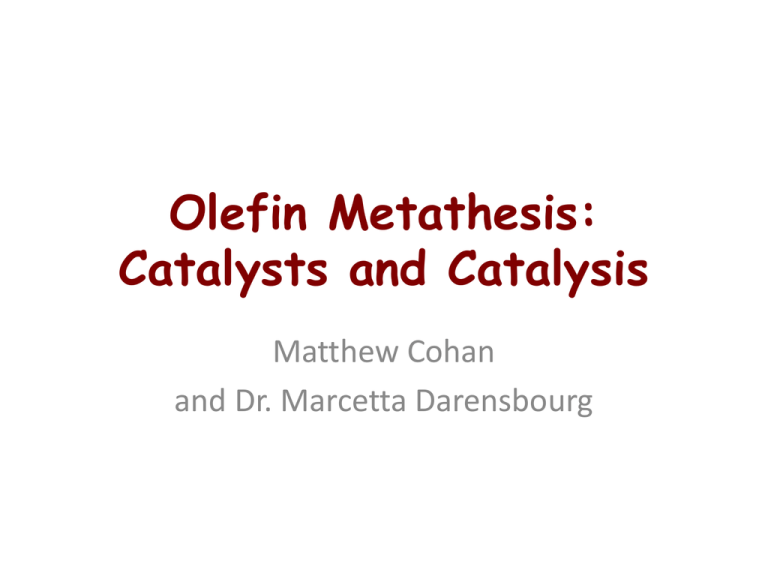
Olefin Metathesis: Catalysts and Catalysis Matthew Cohan and Dr. Marcetta Darensbourg Outline • Introduction – What is metathesis? – Why is it important? • Reactions – Simple synthesis reactions – Catalysis for C-C formation – Olefin metathesis • Historical background – Nobel prizes – Mechanisms • Catalysts types – Grubbs – Schrock • Industrial and Synthetic Organic Applications Metathesis • Metathesis in the general sense is the formation of a product that has exchanged bonds between starting materials. – A-B + C-D A-D + C-B – Double replacement/displacement reaction. • Metathesis in acid-base chemistry and ion exchange is well defined and simple. However, until recently, bond formation in organic reactants is difficult without the presence of catalysts. • In the past 30 years or so industry has used olefin metathesis to form alkenes into other alkenes through a variety of mechanisms. 2 Spessard, G and Miessler, G. Organometallic Chemistry. 2010 Metathesis Reactions • Simplest are ion exchange in salts and acid-base neutralization – KCl + NaF NaCl + KF – H2SO4 + 2NaOH Na2SO4 + 2H2O • More synthetically useful reactions include – The Grignard, Diels-Alder and Wittig reactions Wittig Reaction • Provides the same end goal of C-C bond formation but through a ring opening/closing pathway. A pathway that has similarity to catalytic olefin metathesis. • Then the ring opening step forms the all important C=C bond. • Not Catalytic! Classification of Olefin Metathesis Reactions Ring Opening Metathesis Polymerization: Ring Closing Metathesis; Ring Opening Metathesis Metathesis: Cross Metathesis: Cross Metathesis: Midsize alkenes converted to smaller/ larger alkenes 2 U U from Coleman, Stanford Ring Opening Metathesis Polymerization: Olefin Metathesis Catalysis: The Beginning • Transition metal-chlorides in the presence of co-catalysts were the first to be studied that afforded C-C bond formation, e.g., CH3CH2AlCl2 and WCl6 • Calderon proposed two mechanisms for the above: transalkylation and transalkylidenation. Experiments with deuterated alkenes indicated a transalkylidenation mechanism. • This was the start Grubbs took to find a catalyst to perform synthetically useful reactions. Calderon, N. et al; J. Polym. Sci., Part A1 1967, 5, 2209-2217. A Bit of History for the Olefin Metathesis Reaction Calderon: Isotope distribution studies proved olefin was split at the C=C bond: Phillips Petroleum; 1964: Olefin “Disproportionation” (symmetry forbidden by W-H Rules). Catalysts: W(CO)6, Mo(CO)6, MoxOy/Al2O3 Goodyear Tire Company: Nobel Prizes Historical Frame of Reference “For the development of the metathesis method in organic synthesis.” • Previously mentioned Grignard, Diels-Alder and Wittig reactions awarded in 1912, 1950 and 1979. • Chauvin, Grubbs and Schrock were awarded in 2005 for their work in olefin metathesis. – Preceded by decades of research prior to 2005. • Chauvin was the first to produce a viable mechanism for olefin metathesis. • Schrock accidently created first stable metal carbene catalyst at MIT. • Grubbs gave synthetic chemists an air stable and water-soluble metal carbene. Schrock Grubbs Chauvin Chauvin Mechanism 1971 Olefin Metathesis: Conversion of smaller to larger alkenes; Begins with a Transition Metal Carbene (alkylidene). Other Proposed Mechanisms Rowland Pettit, the Cyclobutane Intermediate Possibility: Robert Grubbs, the Metallocycle Intermediate Possibility: Robert Grubbs, updated : 1976: From Fischer-Type Carbene, Casey discovers valuable clues to mechanism Question to class: Synthesize the tungsten complex beginning from W(CO)6 and PhLi. What else is needed? Other Proposed Mechanisms: Now, getting to the truth: Fred Tebbe, 1976, the Tebbe reagent In 1980 Grubbs uses the Tebbe Reagent and isolates: Class: Can you analyze the Tebbe Reagent? With and without the Me2AlCl? Grubbs also Uses Cp2Ti=CH2 in Natural Product Synthesis Grubbs’ First Generation O.M. Catalyst: Synthesis Grubbs Catalyst: Structure X-ray Diffraction Analysis of Crystals τ = 0.10 Addison’s tau value: trigonal bipyramid has τ = 1; square pyramid has τ = 0.0 Grubbs’ 1st generation Catalyst Complex first needs to lose PCy3 proceeds through Diss. Mech. 16e- complex J. Am. Chem. Soc. 1996, 118, 100-110 Lead up to 2nd Generation Catalyst • Let’s replace PR3 ligand with a heterocyclic carbene and see what happens. – Increased catalytic activity, but why? • [Ru] center prefers basic olefins over rebinding PCy3 Chem. Rev. 2010, 110, 1746–1787 Kinetic Comparison of Phosphines and N-heterocyclic Carbenes (NHC) Class: What is k 2/k-1? Grubbs’ Second Generation O.M. Catalyst Grubbs Catalyst: Structure X-ray Diffraction Analysis of Crystals τ = 0.06 Grubbs’ Catalysts: Comparison of 1st and 2nd Generation Catalysts 1st Generation 2nd Generation τ = 0.10 τ = 0.06 Addison’s tau value: trigonal bipyramid has τ = 1; square pyramid has τ = 0.0 Class: What advantage do the large bulky ligands give? Protection for A reaction pocket. Schrock Catalyst: The First Alkylidene synthesis mechanism First alkylidene structure Schrock Nobel Lecture Schrock: Mo alkylidene selectivity J. Am. Chem. Soc. 2009, 131, 3844; Nature 2011, 471, 461 Hoveyda-Grubbs’ O.M. Catalyst: anchored alkyliden Modifications are endless: Modifications – even more: Ruthenium-based metathesis catalysts 3, 19, and 20. Published in: Georgios C. Vougioukalakis; Robert H. Grubbs; Chem. Rev. 2010, 110, 1746-1787. DOI: 10.1021/cr9002424 Copyright © 2009 American Chemical Society Effects of [Ru] Modification Catalyst Comparisons Grubbs Catalyst(s) • Less reactivity; greater selectivity for less bulky and or strained alkenes • Bench stable • Higher substrate functional group tolerance Schrock alkylidene • Greater reactivity with bulky and e- deficient alkenes • Inert condition-stable • Low substrate functional group tolerance Nobel Chemistry Prize Lectures. Grubbs’ and Schrock’s Applications The SHOP Process Shell Higher Olefin Process J. Chem. Educ. 1988, 65, 605 from Coleman, Stanford Mind Boggling Complexities!!! Applications of Olefin Metathesis: Natural Products Synthesis Applications of Olefin Metathesis: Natural Products, Macrocycles Applications of Olefin Metathesis: Natural Products, RCM
